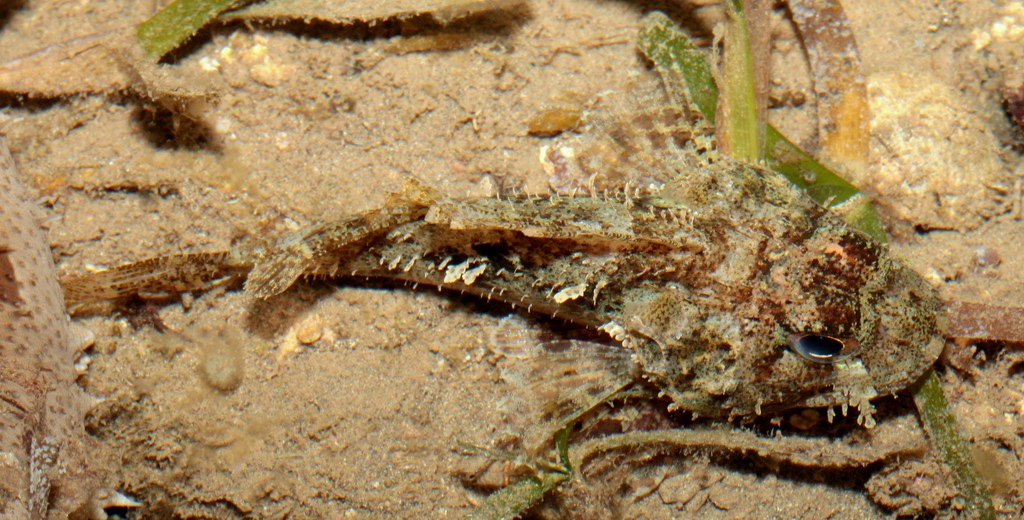PARASCORPAENA PICTA - (CUVIER, 1829)
Actinopterygii (Gigaclass) > Actinopteri (Class) > Teleostei (Subclass) > Perciformes (Order) > Scorpaenoidei (Suborder) > Scorpaenidae (Family) > Scorpaeninae (Subfamily) > Parascorpaena (Genus)
Scorpène peinte, Poisson scorpion peint, Painted scorpionfish, Painted stingfish, Northern scorpionfish, 圓鱗鮋, 花鲉,
Synonymes
Prascorpaena picta (Cuvier, 1829)
Scorpaena lineagula (Fowler, 1955)
Scorpaena picta (Cuvier, 1829)
Scorpaena stokesii (Richardson, 1846)
----------------------
Description
Dorsal spines (total): 12; Dorsal soft rays (total): 8-10 (usually: 9); Anal spines: 3; Anal soft rays: 5; Pectoral fin rays: 19-18 (usually: 17); Caudal fin (branched rays): 11-12; Gill rakers (total): 14-18; Lateral line scales (pored): 22-24; Scale rows in longitudinal series: 43-49 (usually: 45); Scale rows below lateral line: 15-18 (usually: 16); Scale rows between last dorsal fin spine base and lateral line: 6-8 (usually: 7); Scale rows between sixth dorsal fin spine base and lateral line: 6-8 (usually: 7); First and second suborbital ridges fused, forming a single ridge with two spines behind level of orbit, spines absent below eye; Interorbital ridges poorly developed, not encircling a depression; Occipital pit very weakly developed, nearly flat; Smaller head and orbit, head length: 40.1-46.3 % (usually: 43.6 %) of SL and orbit diameter: 10.5-13.0 % (usually: 11.4%) of SL; Shorter upper jaw and pectoral fin, upper-jaw length: 20.0-24.0 % (usually: 21.5 %) of SL and longest pectoral fin ray length: 29.5-36.7 % (usually: 31.8 %) of SL. Max. length: 16.0 cm TL. Depth range: 0 - 15 m.
Scorpène peinte, Poisson scorpion peint, Painted scorpionfish, Painted stingfish, Northern scorpionfish, 圓鱗鮋, 花鲉,
Synonymes
Prascorpaena picta (Cuvier, 1829)
Scorpaena lineagula (Fowler, 1955)
Scorpaena picta (Cuvier, 1829)
Scorpaena stokesii (Richardson, 1846)
----------------------
Description
Dorsal spines (total): 12; Dorsal soft rays (total): 8-10 (usually: 9); Anal spines: 3; Anal soft rays: 5; Pectoral fin rays: 19-18 (usually: 17); Caudal fin (branched rays): 11-12; Gill rakers (total): 14-18; Lateral line scales (pored): 22-24; Scale rows in longitudinal series: 43-49 (usually: 45); Scale rows below lateral line: 15-18 (usually: 16); Scale rows between last dorsal fin spine base and lateral line: 6-8 (usually: 7); Scale rows between sixth dorsal fin spine base and lateral line: 6-8 (usually: 7); First and second suborbital ridges fused, forming a single ridge with two spines behind level of orbit, spines absent below eye; Interorbital ridges poorly developed, not encircling a depression; Occipital pit very weakly developed, nearly flat; Smaller head and orbit, head length: 40.1-46.3 % (usually: 43.6 %) of SL and orbit diameter: 10.5-13.0 % (usually: 11.4%) of SL; Shorter upper jaw and pectoral fin, upper-jaw length: 20.0-24.0 % (usually: 21.5 %) of SL and longest pectoral fin ray length: 29.5-36.7 % (usually: 31.8 %) of SL. Max. length: 16.0 cm TL. Depth range: 0 - 15 m.
Color
Variable, but generally mottled reddish brown. Lacks a black blotch on spinous portion of the dorsal fin.
Etymology
Parascorpaena: from Greek, para = near, in the side + from Latin, scorpaena = a kind of fish. Described as similar to Scorpaena but distinguished by the presence of an anteroventrally directed posterior lacrimal spine.
picta: from Latin, pingo = I paint, having been decorated, painted, portrayed. A manuscript or museum name coined by Kuhl & van Hasselt that Cuvier retained, noting that its marbling and colors are similar to other members of Scorpaena (original genus).
Original description: Scorpaena picta Cuvier, 1829 - Type locality: Java, Indonesia.
Distribution
Eastern Indian Ocean, western Pacific: Sri Lanka and Myanmar, east to Philippines and Fiji, south to northern Australia and New Caledonia.
Variable, but generally mottled reddish brown. Lacks a black blotch on spinous portion of the dorsal fin.
Etymology
Parascorpaena: from Greek, para = near, in the side + from Latin, scorpaena = a kind of fish. Described as similar to Scorpaena but distinguished by the presence of an anteroventrally directed posterior lacrimal spine.
picta: from Latin, pingo = I paint, having been decorated, painted, portrayed. A manuscript or museum name coined by Kuhl & van Hasselt that Cuvier retained, noting that its marbling and colors are similar to other members of Scorpaena (original genus).
Original description: Scorpaena picta Cuvier, 1829 - Type locality: Java, Indonesia.
Distribution
Eastern Indian Ocean, western Pacific: Sri Lanka and Myanmar, east to Philippines and Fiji, south to northern Australia and New Caledonia.
Biology
Inhabits littoral rocky bottom, and in protected bays on silty substrates among debris. Solitary among crevices of coastal reefs. Venomous spines.
Similar species
Parascorpaena aurita (Rüppell, 1838) - Reported from Red Sea; Indo-West Pacific: East Africa (Kenya south to Mozambique), Seychelles, Madagascar and western Mascarenes (La Réunion), east to Philippines, north to Taiwan and Kagoshima Prefecture (southern Japan), south to Great Barrier Reef/Queensland (Australia). Parascorpaena aurita has well developed interorbital ridges forming a broad loop at the rear of the interorbit and enclosing a depression (interorbital ridges weakly or moderately developed in Parascorpaena picta, not enclosing a depression), a fairly well marked depression at the occiput (vs. depression shallow or moderate only in Parascorpaena picta).
Last update: 9, September 2024
Inhabits littoral rocky bottom, and in protected bays on silty substrates among debris. Solitary among crevices of coastal reefs. Venomous spines.
Similar species
Parascorpaena aurita (Rüppell, 1838) - Reported from Red Sea; Indo-West Pacific: East Africa (Kenya south to Mozambique), Seychelles, Madagascar and western Mascarenes (La Réunion), east to Philippines, north to Taiwan and Kagoshima Prefecture (southern Japan), south to Great Barrier Reef/Queensland (Australia). Parascorpaena aurita has well developed interorbital ridges forming a broad loop at the rear of the interorbit and enclosing a depression (interorbital ridges weakly or moderately developed in Parascorpaena picta, not enclosing a depression), a fairly well marked depression at the occiput (vs. depression shallow or moderate only in Parascorpaena picta).
Last update: 9, September 2024
